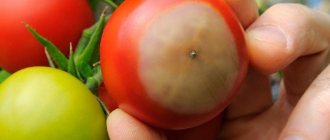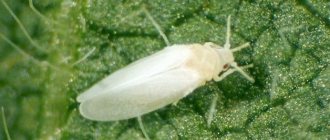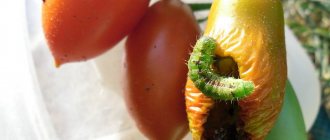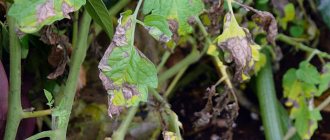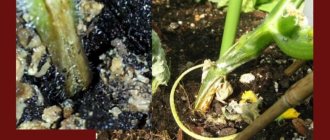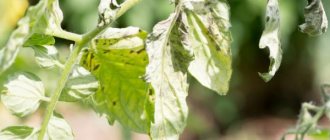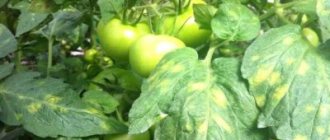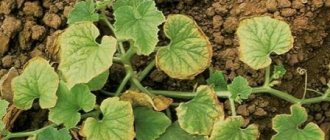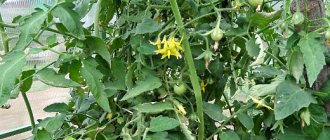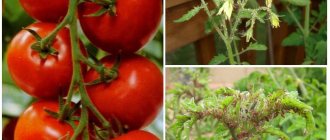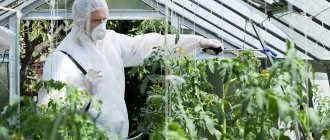Tomatoes are among the most popular agricultural crops.
Almost every summer cottage has beds with this plant. Dear readers!
For you, we have created communities on social networks in which useful articles and interesting ideas are published several times a day! Subscribe and receive useful content in a convenient format! Tomatoes are susceptible to many diseases: fungal, viral, bacterial, caused by insect pests, etc. In this article we will talk about blossom end rot. You will learn what this disease is, why it occurs and how to treat it.
What is blossom end rot of tomatoes?
Blossom rot on tomatoes
Blossom blossom of tomatoes is a non-infectious disease. Most often it occurs due to calcium deficiency in the plant. This element is part of the salts that are needed to form tomato pulp. If there are not enough of them, then tissue necrosis begins in the fetus and the apex turns black.
REFERENCE. The apex is the part of the tomato that is farthest from the stem.
Reasons for appearance
The physiological basis of blossom end rot is a lack of calcium in tomato tissues.
Calcium is involved in the processing and absorption of nutrients (such as starch and protein), and promotes the absorption of nitrogen.
Calcium ions are part of cell walls. The lack of this element leads to cell deformation and the formation of weak integumentary tissues.
Calcium is inactive in the soil and plant tissues. It is distributed throughout the organs of the bushes exclusively by the flow of transpiration - the physiological evaporation of water.
After being absorbed by the roots, the ions move to the parts that most actively evaporate moisture. In tomatoes these are developed mature leaves. The element is not redistributed throughout the plant and cannot move from large leaves to young ones. Fruits evaporate less or no water at all, so calcium deficiency primarily affects them.
Factors leading to calcium deficiency are varied:
- Insufficient watering during the period of mass formation and filling of tomatoes provokes stress. Evaporating leaves draw moisture from the ovaries, and with it the necessary microelements.
- Hot weather increases transpiration and growing tomatoes are left without water and calcium dissolved in it.
- Acidified soil contains few calcium ions in a form available to plants.
- In saline soils, the balance of minerals is disturbed. Thus, with an excess of potassium, sodium and magnesium, the absorption of calcium by tomato roots slows down. A lack of boron has a negative effect on the degree of absorption by plant tissues.
- Excess nitrogen in ammonium form weakens the ability of ions to penetrate the roots.
Varietal characteristics also influence the development of blossom end rot. Large-fruited or elongated tomatoes, as well as early-ripening varieties, are more often affected by this disease.
Why does disease develop in tomatoes?
There are many reasons for calcium deficiency. The most important of them is the insufficient amount of this microelement in the soil. Among others, the following can be noted:
- Moisture deficiency in the soil. Because of this, calcium is simply not absorbed by the roots of the plant.
- Excess moisture in the soil. When water stagnates in the soil, as well as the proximity of groundwater, calcium is washed out of the soil. Accordingly, the plant has nowhere to get the required amount of this microelement.
- Chemical composition of the soil . If the soil is too saline or acidic, it will not have enough calcium.
- Root injuries. Tomatoes take nutrients from the soil using the root system. If it is damaged, the plant will not be able to receive microelements and will begin to hurt. Including apical rot.
- Stress. Tomatoes are a crop that does not like sudden changes in growing conditions. Watering with cold water, a sharp change in temperature - all this negatively affects tomatoes and leads to calcium deficiency. For example, when watering with cold water, the roots cannot absorb nutrients for some time.
Causes
It would seem why apical necrosis appears on tomato fruits, because there is plenty of calcium in nature. It is contained in the soil, water from a well and a water supply system, which is usually used to water tomatoes in open ground or greenhouses - not every site has a filter unit. Dry rot, although uncommon, can occur even on calcareous soils.
Most often, apical lesions of fruits on tomatoes and other nightshades appear not due to a lack of calcium, but due to an imbalance of nutrients. But some gardeners believe that manufacturers came up with specialized fertilizers for different crops in order to earn more money. Meanwhile, agrochemistry is a science.
If a gardener does not want to buy specially balanced fertilizers for each crop separately, you need to independently study its needs and the characteristics of the interaction of nutrients. And don’t thoughtlessly sprinkle what you have on the farm under tomatoes and other plants.
The role of potassium and wood ash in the occurrence of blossom end rot
If gardeners have sorted things out a little with nitrogen, and no longer pour green fertilizers or mullein infusion anywhere and anytime, then ash continues to be considered completely harmless and safe. But it is its excessive use that often causes rot to appear on tomatoes.
Potassium is a calcium antagonist that prevents its absorption by plants. In order for both substances to be absorbed normally, their balance must be 1(K):0.7(Ca). That is, for every kilogram of potassium added to the soil, 700 g of calcium is needed. Moreover, both elements must be in an easily accessible form.
It happens that tomatoes start to get sick only because too much ash has been added to the soil. The result is an imbalance between potassium and calcium, the crop is dying, and the owners do not understand the reason - caring for the tomatoes was ideal.
Advanced gardeners may argue that the already mentioned ash is a source of both potassium and calcium. Moreover, when burning most plant residues, the balance of these elements is close to ideal.
If there are no problems with potassium, it is well absorbed by plants, including tomatoes, then with calcium the story is completely different. In the same ash it is contained in a hard-to-reach form. And it is released slowly, often over several years. The tomato immediately receives the dose of potassium contained in the ash. Calcium will begin to act, at best, the next season.
What else interferes with calcium absorption?
It is not only the high potassium content in fertilizers or soil that can hinder calcium absorption. The disease is caused by blossom end rot:
- soil salinization;
- damage to tomato roots;
- alternating periods of drought and waterlogging, especially dangerous when fruit is filling;
- excess nitrogen fertilizing;
- heat.
Signs of infection
Initial stage of the disease
The most important symptom of the disease is the appearance of a yellow-brown spot on the top of the tomato. In this case, signs of blossom end rot begin to appear on fairly developed fruits. During the ripening process, the spot becomes dark brown and seems to be pressed into the inside of the tomato.
Blossom rot is not the result of infection or pest action, but the affected area is often the site where fungus soon begins to develop.
Another symptom of the disease is rotting of the fruit pulp without external changes. In this case, it is impossible to detect the disease before harvesting.
REFERENCE. A tomato affected by blossom end rot turns red earlier than others. But usually on one bush almost all the fruits suffer from blossom end rot.
Signs
First, small dry brown spots appear on the leaves. They grow until they cover the entire surface and also affect the stem, which they cover in concentric rings. As the ovaries begin to ripen, spots appear on the tomatoes. They may be brown or black, and the dead tissue dries out and cracks. If there is high humidity in the greenhouse, then a velvety black coating consisting of putrefactive bacteria appears on the spots.
The higher the humidity, the faster and more intensely the disease spreads.
Fruits that are partially affected by rot late in life are still edible if the affected areas are trimmed off, but they cannot be stored.
Treatment of blossom end rot in tomatoes and is it possible to save the plants?
Blossom rot does not affect the entire plant, so if detected in a timely manner, the bush can be saved.
Firstly , you need to pick off the affected fruits. Under no circumstances leave them to rot in the garden beds. Sick tomatoes should be disposed of outside the garden.
Secondly , the plant needs to be fed with fertilizer with a high calcium content (for example, calcium nitrate or potassium chloride). Saturation with this microelement will stop the development of the disease.
Thirdly , cultivate the soil. Loosen it if it gets crusty. Water if it is completely dry.
Affected fruits must be destroyed
What medications to treat for the disease
Chemicals are the most effective remedy for blossom end rot. The fact is that they already contain the required dose of calcium.
IMPORTANT! Before feeding tomatoes, they must be watered abundantly. This way, minerals will be better absorbed by plants.
Among the most effective drugs:
- Calcium nitrate. Spraying with a solution (10 g per 10 liters of water).
- Potassium chloride. Spraying with a solution (30 g per 10 liters of water).
- "Brexil Sa." Treatment of leaves and stems with a solution (10 g per 10 l of water).
- "Nutrivant PLUS" and "Fertivant" . Spraying with a solution of 2 drugs (30 g per 10 liters of water).
Nutrivant PLUS
Treatment with these agents should be carried out every 1.5 - 2 weeks after detection of the disease. If new fruits do not show signs of blossom end rot, then spraying can be stopped.
Treatment with folk remedies
If you prefer traditional methods, then, first of all, you need to pay attention to wood ash, soda, chalk and oak bark . Fertilizers based on these products are rich in calcium. Fertilizers are applied in liquid form and mainly by foliar application (spraying). Only the chalk “chatter” is applied at the root.
- Ash based fertilizer. 1 glass is sifted and mixed with 1 glass of boiling water. The concentrate is infused for a day, after which it is diluted with 9 liters of water.
- Chalk "chatterbox". Watering with a solution (100 g per 10 liters of water) under the root.
- Oak bark is ground into crumbs. A teaspoon of the product is poured into 1 liter of water and boiled for 10 minutes. Then the concentrate is diluted with 9 liters of water.
- Soda solution. 2 teaspoons are diluted in 10 liters of water.
Treatment with solutions should be carried out once a week. The entire bush is processed. And fruits, and leaves, and stems. Particular attention should be paid directly to tomatoes. If symptoms of blossom end rot no longer appear, treatment should be stopped.
IMPORTANT! There is no need to process tomatoes after the signs of the disease disappear. An excess of any microelements is also harmful to plants.
Treatment
There are many products on the market that can be used to treat tomatoes against disease. For prevention and at the beginning of infection, the drug “Quadris” is suitable. It is diluted according to the instructions and sprayed on the bushes.
In case of severe infection, Ridomil Gold will help. Prepare a solution for spraying at a concentration of 0.25%. The treatment is repeated after 1-2 weeks with another drug, for example, “Bravo” or “Oxychom”.
If the disease is caused by stink bugs that parasitize the bushes, they are also treated with insecticides against bedbugs.
It is necessary to change medications because the fungus develops resistance to them.
How to deal with rot on tomatoes in a greenhouse?
Methods of combating blossom end rot on tomatoes growing in a greenhouse are also aimed at eliminating calcium deficiency in the soil and creating favorable conditions for plants.
Small differences are due to the fact that tomatoes in a greenhouse are less susceptible to atmospheric influences.
Firstly , watering is carried out only by hand. Therefore, it is important to establish a regime of watering and subsequent loosening of the soil.
Secondly , it is necessary to regularly ventilate the greenhouse to ensure a flow of fresh air.
Otherwise, you can use the same means as in the fight against blossom end rot on open ground tomatoes.
Prevention
To protect tomatoes from disease, it is necessary to carry out agrotechnical prevention, which includes:
- compliance with crop rotation;
- deep autumn digging of the soil;
- disinfection of soil and seed;
- timely elimination of pests;
- compliance with the watering regime;
- regular ventilation of the greenhouse;
It is also necessary to apply fertilizing rich in potassium, and to prevent nutrient deficiency in the soil. During sowing, a 1% solution of Trichodermin is added to the wells at the rate of 3 ml per bush. Later, for preventive purposes, foliar treatment with the same drug can be carried out.
Are there resistant varieties?
One of the most effective methods of resisting blossom end rot is the selection of disease-resistant varieties.
Early-ripening and large-fruited varieties and hybrids of tomatoes are most susceptible to the disease. For example, “Azhur”, “Sprint Timer” and “Alabai”. During development, tomatoes of these varieties very quickly consume too much energy. Therefore, if they are not carefully looked after and fertilized, they may get sick.
The varieties and hybrids least susceptible to blossom end rot are “Bolshevik”, “Belyi Naliv”, “Pandarose”, “Volgogradsky”, “Lunny”, “Benito”, “Astrakhansky”, “Raisa”, etc. Most of these tomatoes are unpretentious in care and can withstand climatic changes and irregular watering regimes.
Variety White filling
Disease prevention
It is much more effective to prevent the occurrence of a disease than to fight it. Prevention of blossom end rot is carried out throughout the summer season. It is very important to take into account the climatic characteristics of the region, as well as the fertility and chemical composition of the soil.
In addition, it is very important to properly care for tomatoes: water and feed them on time, rooting, treating with insecticides and fungicides, loosening the soil, etc.
The fact is that crown rot is not the result of an infection or fungus. In most cases, the disease is associated with improper care of plants and soil.
That's why:
- Carry out regular loosening on heavy soils and with high groundwater levels.
- Do not allow the soil under the tomatoes to dry out.
- On heavy soils, carry out liming in the fall after the end of the dacha season.
- Mulch tomato bushes.
- Fertilize the soil on the site in spring and autumn.
- Keep an eye on your tomatoes and conduct regular inspections for diseases and pests.
Prevention of rot on tomatoes
During drought, the best prevention of blossom end rot is drip irrigation. The tomatoes do not experience a lack of moisture, and, at the same time, there are no sudden changes in soil moisture that negatively affect the ripening of tomatoes. If the cause of the disease is a lack of moisture, then with drip irrigation it will never appear.
Proper watering also prevents the occurrence of disease. In the south, in hot weather, tomatoes are watered in a greenhouse every 2-4 days. The main criterion is that the soil dries out by 3-4 cm. You can determine the humidity by sticking a stick into the ground to a depth of 5-6 cm. If the earth sticks to it, then the soil is moist and watering is not required, but if the stick is covered with dust or the earth sticks only to at its end, it is necessary to water.
Acidic soils are deoxidized by applying lime fertilizers in the fall. The only exception is the fluff. It gives a quick but short-term effect, so it is applied in the spring when digging up a greenhouse or future tomato plot, but before planting seedlings.
Calcareous soils are not limed, since calcium is found in excess there, and its additional application only increases the alkalinity of the soil. The disease occurs due to the fact that it is contained in a form inaccessible to plants. Here, when planting seedlings, 1 teaspoon of eggshells or ash is added directly to the hole.
Treating tomatoes with baking soda, as some recommend, is useless. It does not contain calcium, which is so necessary for treating tomato rot. All it contains is sodium and carbonic acid, which tomatoes do not need. The effect of such treatment is zero.
How to prepare seeds so that tomatoes do not get sick?
Treating seeds in potassium permanganate
Proper preparation of seeds will prevent disease even for those varieties that are more prone to blossom end rot than others.
In order to prevent disease, tomato seeds must be pickled in a solution of potassium permanganate or iron sulfate before planting.
- Etching with potassium permanganate. A 3% solution is prepared. The seeds are soaked in it for 30-40 minutes. Then the planting material is washed in warm water and dried.
- Pickling with iron sulfate. A solution is prepared (1 g of vitriol per 1 liter of water). The seeds are soaked in it for 24 hours. After this, the planting material is also washed and dried.
IMPORTANT! If your soil is too low in calcium or you severely damage the plant's roots, seed dressing still won't help.
Preventive measures
Moderate watering of plants and maintaining good aeration of the roots will prevent the development of the disease. The culture is contraindicated in excess moisture or drought, otherwise transformations will begin to occur at the cellular level. Tomatoes become weaker and become a good target for disease. The rules of crop rotation, treatment of seeds and soil will protect you from problems. Soil with a normal pH level will prevent blossom end rot. If the soil is acidic, liming is recommended. In autumn, 200 g of dolomite flour or chalk is added to 1 square. The use of calcium sulfide (40 g/1 m2) will help normalize alkaline soil. Crowded plant cultivation causes disease. Seedlings are planted at a distance of at least 50 cm from the neighboring specimen. A handful of wood ash with crushed eggshells is poured into each hole. During the season, the crop is sprayed with Brexil Ca. Blossom rot is an unpleasant disease that begins to develop due to errors in agricultural technology. If the plant is not treated, the fruits lose their presentation, keeping quality and taste. Timely and proper care will prevent the onset of the disease. In the early stages, folk remedies will help to cope with the problem; in advanced stages, chemicals are used.
Answers to frequently asked questions
Where does blossom end rot come from?
Blossom rot is a disease that is associated with calcium deficiency. Without this element, the plant cannot fully form the fruit, on which tissue begins to die. The tomato begins to turn black.
How to feed tomatoes so they don't get sick?
First of all, fertilizers containing calcium. Foliar feeding, that is, spraying, is much more effective.
Does the soil need to be tilled?
Tomatoes get calcium from the soil, so it also needs to be processed. On acidic soils, liming is carried out in the fall. This is necessary to reduce the acidity of the soil. Liming can also be carried out in the spring, but the effect will be slightly lower.
Only the very tip of the tomato turned black. What to do with him?
Pluck from the branch and throw outside the garden or summer cottage. There is no need to eat a diseased tomato, even if you cut off the infected part. Eating contaminated tomatoes can cause gastrointestinal upset and several days of fever.
The tomatoes on the tomato bush are turning black. What to do with the plant itself?
Treat using the methods described. If treatment does not help, then the infected bush should be pulled out and burned outside the summer cottage.
Reasons for the development of blossom end rot on tomatoes
Lack of moisture and hot air lead to intense evaporation of liquid from the leaves and trunk. If moisture is not provided through the root system during this period, the plant begins to suck it out of the fruit. As a result, some of the fruit cells die and tomato blossom end rot develops, the treatment of which is much more difficult and labor-intensive than the prevention of infection.
Other reasons for the development of blossom end rot in tomatoes include:
- Lack or excess of calcium;
- Excess nitrogen;
- High soil acidity.
